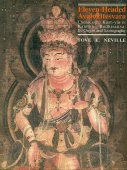Jumping: 1 definition
Introduction:
Jumping means something in Hinduism, Sanskrit. If you want to know the exact meaning, history, etymology or English translation of this term then check out the descriptions on this page. Add your comment or reference to a book if you want to contribute to this summary article.
In Hinduism
Natyashastra (theatrics and dramaturgy)
Source: Shodhganga: Elements of Art and Architecture in the Trtiyakhanda of the Visnudharmottarapurana (natya)The Jumping (of birds) is associated with Samapāda: one of the “six kinds of Standing Postures for Men” (in Indian Dramas), according to the Viṣṇudharmottarapurāṇa, an ancient Sanskrit text which (being encyclopedic in nature) deals with a variety of cultural topics such as arts, architecture, music, grammar and astronomy.—Standing postures are determined separately for male and female. In the Viṣṇudharmottarapurāṇa six kinds of standing postures are discussed for men. The word sama denotes the equal position. In samapāda position, both the legs are placed at a distance of one tāla. This posture is seen in the auspicious performance of Brahmins. This posture is also used to denote jumping of birds and sitting in chariot or aeroplanes.

Natyashastra (नाट्यशास्त्र, nāṭyaśāstra) refers to both the ancient Indian tradition (shastra) of performing arts, (natya—theatrics, drama, dance, music), as well as the name of a Sanskrit work dealing with these subjects. It also teaches the rules for composing Dramatic plays (nataka), construction and performance of Theater, and Poetic works (kavya).
See also (Relevant definitions)
Starts with: Jumping-bean tree.
Full-text (+250): Abhilanghana, Plavana, Jhampa, Parilanghana, Utkurdana, Utplavana, Langhana, Avalgita, Valgana, Paryavaskanda, Ullanghana, Uddana, Lasa, Shashat, Duraplava, Cancatka, Duragusala, Bakarakudai, Taranga, Askandin.
Relevant text
Search found 101 books and stories containing Jumping; (plurals include: Jumpings). You can also click to the full overview containing English textual excerpts. Below are direct links for the most relevant articles:
The Tattvasangraha [with commentary] (by Ganganatha Jha)
Verse 3421-3424 < [Chapter 26 - Examination of the ‘Person of Super-normal Vision’]
Verse 3425-3427 < [Chapter 26 - Examination of the ‘Person of Super-normal Vision’]
Verse 3168 < [Chapter 26 - Examination of the ‘Person of Super-normal Vision’]
Brihad Bhagavatamrita (commentary) (by Śrī Śrīmad Bhaktivedānta Nārāyana Gosvāmī Mahārāja)
Verse 2.4.251 < [Chapter 4 - Vaikuṇṭha (the spiritual world)]
Verse 1.6.121 < [Chapter 6 - Priyatama (the most beloved devotees)]
Garga Samhita (English) (by Danavir Goswami)
Verse 6.15.2 < [Chapter 15 - The Glories of Nṛga-kūpa and Gopī-bhūmi]
Verse 6.2.47 < [Chapter 2 - Residence in Śrī Dvārakā]
Verse 5.8.26 < [Chapter 8 - The Killing of Kaṃsa]
Chaitanya Bhagavata (by Bhumipati Dāsa)
Verse 2.4.17 < [Chapter 4 - Revelation of Nityānanda’s Glories]
Verse 2.26.48 < [Chapter 26 - Descriptions of the Mercy Bestowed on Śuklāmbara and Vijay and the Lord’s Desire to Accept Sannyāsa]
Verse 2.19.94 < [Chapter 19 - The Lord’s Pastimes in Advaita’s House]
Animal Kingdom (Tiryak) in Epics (by Saranya P.S)
Chapter 4.15 - The Monkey in the Epics
Chapter 4.6 - The Bull in the Epics
Nitiprakasika (Critical Analysis) (by S. Anusha)
Gadā (Mace) < [Chapter 3]
Related products


